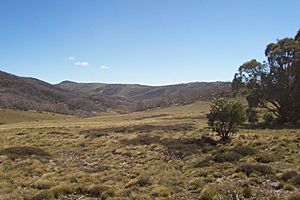Maisie Carr facts for kids
Quick facts for kids
Maisie Carr
|
|
|---|---|

Maisie Carr (née Fawcett), 1944
|
|
| Born | 26 February 1912 Footscray, Victoria
|
| Died | 9 September 1988 (aged 76) |
| Resting place | Gungahlin Cemetery |
| Alma mater | University of Melbourne |
| Spouse(s) | Denis John Carr |
| Scientific career | |
| Fields | Botany, ecology |
| Institutions | University of Melbourne |
Maisie Carr (born Stella Grace Maisie Fawcett; 1912–1988) was an amazing Australian scientist. She was an ecologist and botanist. This means she studied how plants live and interact with their environment. Maisie helped us understand the special plants of Australia and their unique natural systems.
Contents
Early Life and Education
Maisie Carr was born Stella Grace Maisie Fawcett in Footscray, Victoria, a suburb of Melbourne. Her parents were not scientists. But Maisie grew to love plants by visiting nearby salt-marshes and her grandmother's garden. She also enjoyed nature study classes.
Maisie, as she was always called, went to Hyde Street State School in Footscray. She was a very bright student. In 1924, she was the top student in her class. After that, she attended Melbourne High School.
After finishing high school, Maisie worked as a junior teacher at her old primary school. At night, she studied zoology (animals) and geology (Earth's rocks and soil). She then went to the University of Melbourne. She earned her Bachelor of Science (B.Sc.) degree in 1935. The next year, she received her Master of Science (M.Sc.) in Botany.
Maisie was very good at her studies. She won several scholarships. These awards helped her pay for her education. One scholarship was for natural history. Another was for botany, the study of plants.
Important Research Work
Studying the Australian Alps
Maisie first studied coral fungi. She also looked at plant diseases caused by fungi and tiny worms called nematodes. As a student, she went on field trips with a science society. These trips prepared her for her future work. In 1936, she explored the Sir Joseph Banks Group of islands in South Australia. She helped with a full scientific survey of these islands.
From 1941, Maisie did a lot of new research in the Australian Alps. This is a mountain area in Australia. At that time, too many cattle and sheep were eating the plants there. This was causing soil erosion and damaging the delicate environment. Farmers had been grazing animals in these high plains since the late 1880s. The damage from these animals also allowed rabbits to arrive in the 1920s, causing even more problems.
Scientists were also worried about soil washing into the rivers. This could harm the new Kiewa Hydroelectric Scheme, which was being built to make electricity. Maisie was the first research officer for the Soil Conservation Board. She set up special fenced areas in the Bogong High Plains. These fences kept grazing animals out of certain plots of land.
Maisie and her team watched these plots for decades. They compared the plants inside the fences to those outside. They recorded how the plants grew back and changed. In the early years, Maisie surveyed these plots on horseback by herself. Later, teams from the University of Melbourne helped her. These plots became the longest ongoing study of an ecosystem in Australia.
Timeline of Alpine Ecology
Here are some important events in the study of the alpine environment, and Maisie Carr's role:
- 1944: The Soil Conservation Board was created. Maisie Carr became a Research Officer.
- 1945: Fenced areas (exclusion plots) were set up in Rocky Valley.
- 1946: More exclusion plots were set up in Pretty Valley.
- 1947: A report on the environment of the Hume Catchment area was published.
- 1966: Maisie went on one of her last expeditions to the High Plains.
- 1968: Grazing by animals slowly stopped in Kosciuszko National Park.
- 1991: Grazing was reduced to only 20% of the Bogong High Plains.
- 2005: Grazing was completely banned from the Victorian Alpine National Park.
Studying Eucalyptus Trees
While working on the alpine studies, Maisie found it hard to identify plants. So, she started making her own plant identification guide. This guide grew into a collection of 100-200 plant samples. These samples are still used today for teaching and research.
Maisie did much of this early plant identification work at the University of Melbourne. She started working there in 1949 in the Botany Department. She taught about plant taxonomy (how to classify plants) and ecology. Three years later, she became a senior lecturer.
Maisie and Professor John Stewart Turner published reports about their fenced experiments. They showed how grazing animals were destroying the plants and causing soil degradation in the Victorian alpine region.
Maisie was also very interested in classifying Australian plants, especially the Eucalyptus genus. Her interest grew when she married Denis John Carr in 1955. He was also a botany professor at the University of Melbourne. Their marriage led to many years of working together. They studied plant morphology (the structure of plants) and taxonomy.
They continued their studies when Denis worked in Belfast (1960-1967). Later, they moved back to Australia. Denis worked at the Australian National University in Canberra starting in 1968. Maisie was a visiting fellow there. Together, they wrote many scientific articles.
Maisie and Denis believed that the Eucalyptus genus should not be split into smaller groups. However, they made big contributions to describing the different parts of eucalypts. Later studies, using DNA, showed that Eucalyptus was not a single, simple group. The way they were classified needed to be changed. Today, there is a system called EUCLID. It helps identify and provides information on 894 Australian eucalypts.
Legacy
The University of Melbourne has created scholarships in Maisie Carr's honor. They are called the Maisie Fawcett Scholarships.
See also
 In Spanish: Stella Grace Maisie Carr para niños
In Spanish: Stella Grace Maisie Carr para niños




